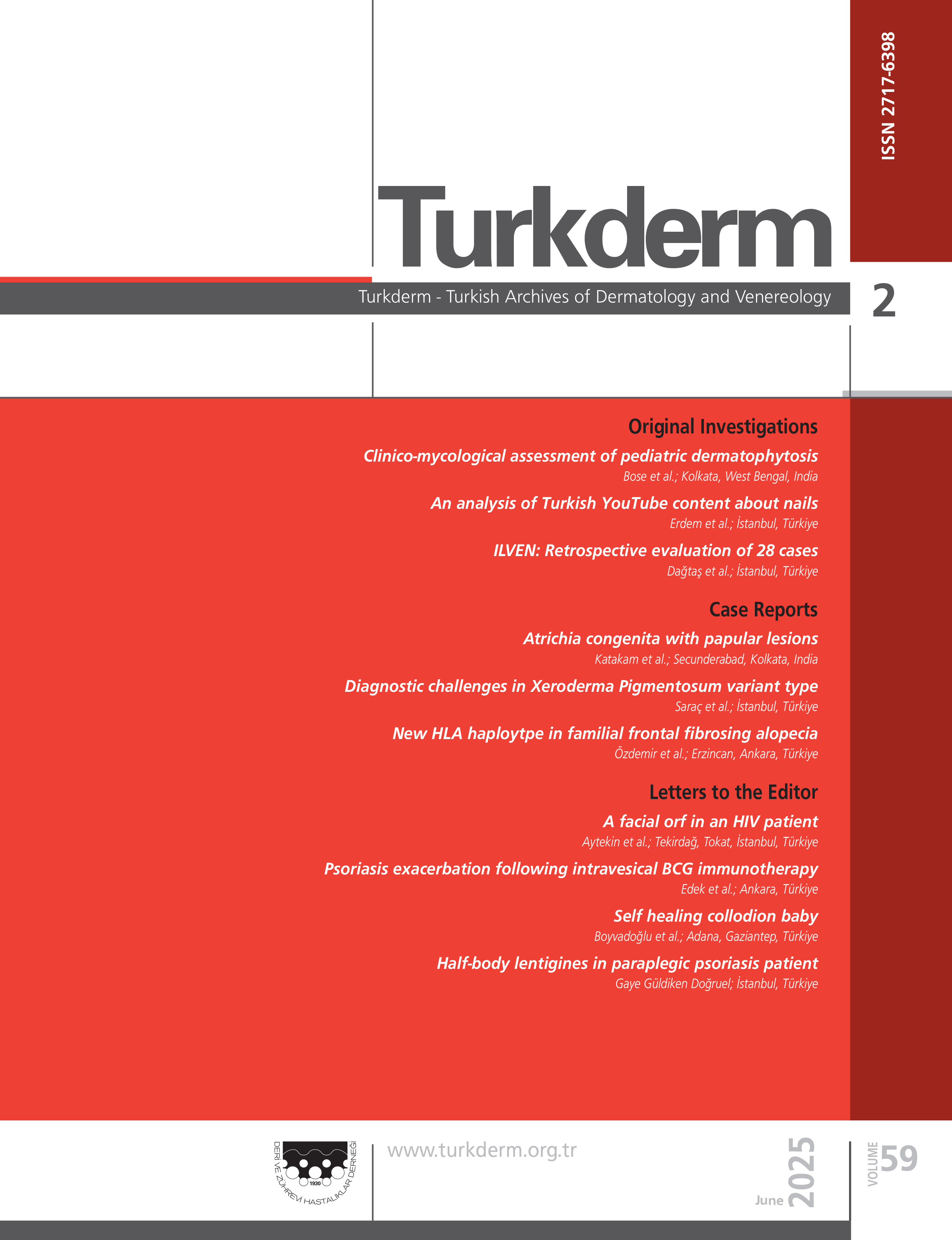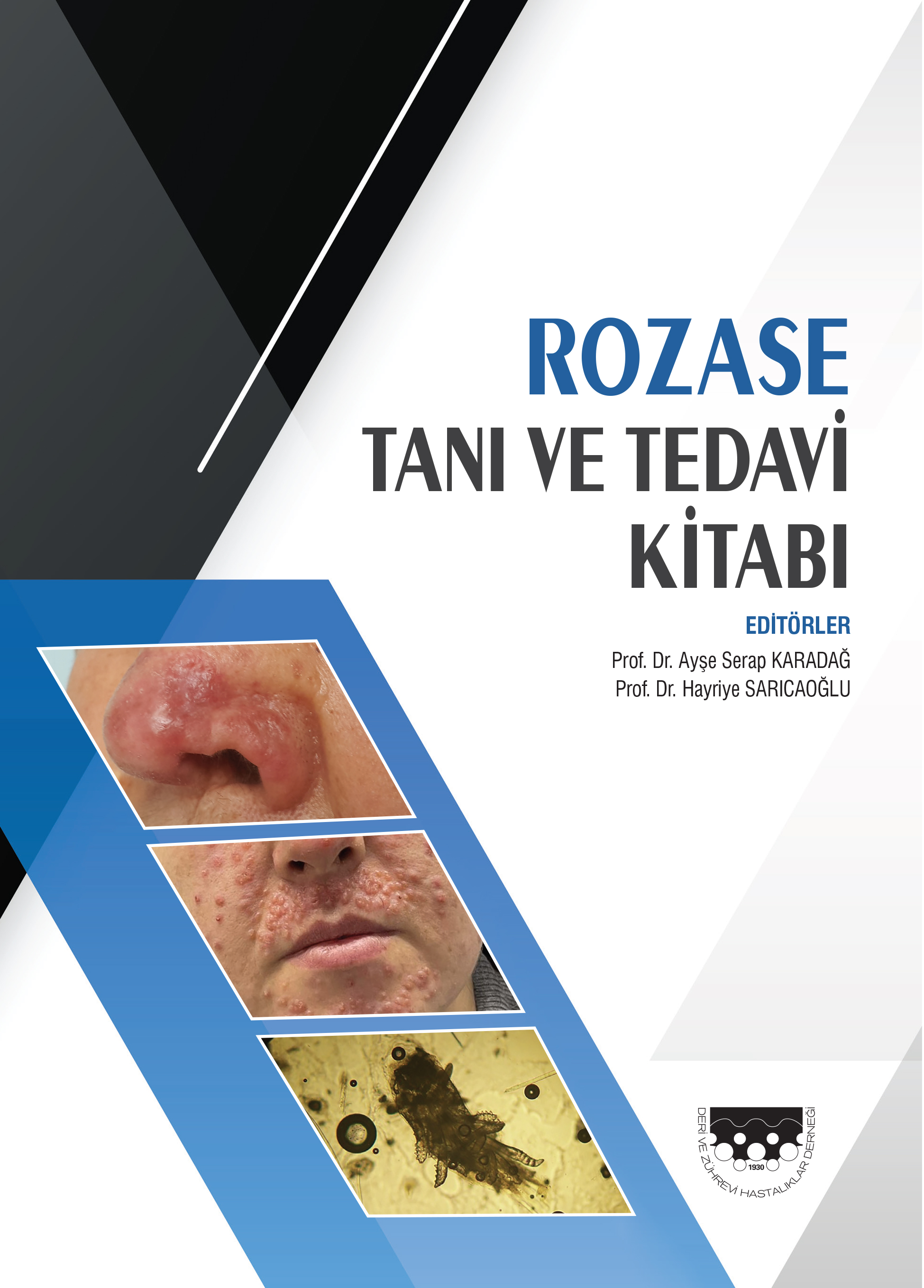Volume: 50 Issue: 4 - 2016
| ANNOUNCEMENT | |
| 1. | Sağlıklı, mutlu, verimli bir yeni yıl dileriz Page I |
| ORIGINAL INVESTIGATION | |
| 2. | Classic Kaposis sarcoma: The clinical, demographic and teratment characteristics of seventy-four patients Beril Gülüş Demirel, Rafet Koca, Nilgün Solak Tekin, Nilüfer Onak Kandemir, Banu Doğan Gün, Fürüzan Köktürk doi: 10.4274/turkderm.35336 Pages 136 - 140 Background and Design: Classic Kaposi's sarkoma (CKS) is a rare disease, generally seen across Mediterranean and the Middle East region. It's an angioproliferative disorder associated with human herpes virus-8 infection. There is a few data on epidemiology and clinical characteristics among Turkish patients with CKS. This study aims to evaluate epidemiologic, clinical characteristics and treatment results in patients with the diagnosis of CKS in Zonguldak. Materials and Methods: We retrospectively evaluated the hospital records of patients with CKS who attended the dermatological and venereal diseases department between 2003 and 2014. Seventy-four patients were included in this study. Demographic and clinical characteristics, applied treatments and responses to treatments were evaluated. Results: During the eleven year examination period, 74 CKS patients have been diagnosed in the dermatology clinic. The prevalence of CKS among dermatologic patients was found to be 0.02%. Patient age at diagnosis ranged from 33 to 90 years (mean: 70.2±11.7). Fifty-two patients were male (70.3%) and 22 patients were female (29.7%). Multiple nodules were the most frequently seen clinical forms and the distal lower extremity was the most common site of involvement (80.6%). According to the CKS staging system, it was observed that 47 patients (62.7%) were at stage 1, 11 patients (15.49%) at stage 2, eight patients (10.7%) at stage 3, and six patients (8%) were at stage 4. Treatment options were excision for 35.1% of patients (n=26), radiotherapy for 25.7% of patients (n=19), cryosurgery for 14.9% of patients (n=11), and chemotherapy for 10.8% of patients (n=8). Relapse was found to occur most commonly after excision (58.3%). Conclusion: Larger, multicenter studies are needed in order to determine the prevalence of CKS and characteristics of patients with CKS in our country. |
| 3. | The prevalence of psoriasis in Trabzon Savaş Yaylı, Murat Topbaş, Deniz Aksu Arıca, Sibel Tuğcigil, Erhan Çapkın, Sevgi Bahadır doi: 10.4274/turkderm.75735 Pages 141 - 144 Background and Design: Psoriasis is a chronic inflammatory skin disease affecting nearly 2% of the population. In Turkey, the only data about the prevalence of psoriasis from a population-based study is the data of the prevalence of 0.5% in a small district in a rural area. We aimed to provide the first large-scale data in Turkey by determining the prevalence of psoriasis in a large area, in the central and outlying districts of the province of Trabzon. Materials and Methods: A random sample of 7885 (4057 male and 3828 female) adults was collected by using the stratified sampling technique. The study was performed with face-to-face questionnaire administration with participants selected according to the place of residence, gender and age groups. Psoriasis was diagnosed based on the questionnaires filled by patients during these interviews. Crude psoriasis prevalence ratios and age-adjusted psoriasis prevalence ratios according to the Segi population were calculated and presented with 95% confidence interval (CI). Results: Of 7885 people, 87 were diagnosed with psoriasis, of which 45 were female and 42 were male. The prevalence of psoriasis was found to be 1.1% (95% CI: 0.9-1.3) in the general population. The prevalence of psoriasis in females (1.2%) was higher than that in men (1.0%). Age-adjusted prevalence was 3.9% (95% CI: 3.5-4.3) and 1.0% (95% CI: 0.8-1.2) for females and males, respectively. The presence of a family history of psoriasis increased the psoriasis risk by eight-fold (p<0.001). Conclusion: We found that the prevalence of psoriasis was 1.1% in a large area, in the central and outlying districts of the province of Trabzon. Our study reveals that the prevalence of psoriasis in our country may be lower than that in Northern Europe and North America. |
| 4. | Dermatological face of Syrian civil war Rahime İnci, Perihan Öztürk, Mehmet Kamil Mülayim, Ali Karakuzu, Kıymet Handan Kelekçi, Mehmet Fatih İnci, Şemsettin Karaca doi: 10.4274/turkderm.62443 Pages 145 - 149 Background and Design: The frequency and variety of dermatological diseases significantly changed after 2011 in the regions where the Syrian refugees migrated because of the civil war in Syria where is bordered by our country. To reveal these changing, the demographic and dermatological data of the Syrian refugees were retrospectively examined in faculty of medicine, department of dermatology of our city where a significant amount of Syrian refugees have been living. Materials and Methods: A total of 326 refugees immigrated to our city and have been living in tent cities, and applied to our department between September 2012-July 2014 were included to our study. Age, gender, dermatological and laboratory findings were retrospectively examined. Skin diseases were examined in 16 groups according to the their frequency. The patients were divided into 4 age groups as 0-20, 21-40, 41-60 and, 61 and over; three most common diseases for each age group were analyzed. Results: Of 326 patients, 126 (38.7%) were males, 200 (61.3%) were females and the difference was significant in term of gender. The age range of the patients was 0 to 77 years, and the mean age was 21.6±10.5. The majority of patients were in 0-20 age group. Dermatological infectious diseases were the most frequent diseases group and cutaneous leishmaniasis was the most diagnosed dermatological disease among patients. Conclusion: Preventive health care services should be performed to prevent dermatological infectious diseases which are commonly seen in Syrian refugees, especially cutaneous leishmaniasis which is already endemic in our country, and limitations to reach physicians of these patients should be amended. |
| 5. | Evaluation of patients with oral lichenoid lesions by dental patch testing and results of removal of the dental restoration material Emine Buket Şahin, Fatma Çetinözman, Nihal Avcu, Ayşen Karaduman doi: 10.4274/turkderm.86836 Pages 150 - 156 Background and Design: Oral lichenoid lesions (OLL) are contact stomatitis characterized by white reticular or erosive patches, plaque-like lesions that are clinically and histopathologically indistinguishable from oral lichen planus (OLP). Amalgam dental fillings and dental restoration materials are among the etiologic agents. In the present study, it was aimed to evaluate the standard and dental series patch tests in patients with OLL in comparison to a control group and evaluate our results. Materials and Methods: Thirty-three patients with OLL or OLP and 30 healthy control subjects, who had at least one dental restoration material and/or dental filling, were included in the study. Both groups received standard series and dental patch test and the results were evaluated simultaneously. Results: The most frequent allergens in the dental series patch test in the patient group were palladium chloride (n=4; 12.12%) and benzoyl peroxide (n=2, 6.06%). Of the 33 patients with OLL; 8 had positive reaction to allergents in the standard patch test series and 8 had positive reaction in the dental patch test series. There was no significant difference in the rate of patch test reaction to the dental and standard series between the groups. Ten patients were advised to have the dental restoration material removed according to the results of the patch tests. The lesions improved in three patients [removal of all amalgam dental fillings (n=1), replacement of all amalgam dental fillings with an alternative filling material (n=1) and replacement of the dental prosthesis (n=1)] following the removal or replacement of the dental restoration material. Conclusion: Dental patch test should be performed in patients with OLL and dental restoration material. Dental filling and/or prosthesis should be removed/replaced if there is a reaction against a dental restoration material-related allergen. |
| CASE REPORT | |
| 6. | Acquired aquagenic acrokeratoderma: A case series Nebahat Demet Akpolat, Fadime Kılınç, Ayşe Akbaş, Ahmet Metin doi: 10.4274/turkderm.89656 Pages 157 - 159 Aquagenic syringeal acrokeratoderma (ASA) is a rare kind of an acquired keratoderma that predominantly affects adolescents and young females. The etiology is unknown. Clinically, ASA is characterized by transient edematous white papules and plaques occurring a few minutes after exposure to water. It is most commonly localized on the palms, but may also affect the plantar area and dorsum of the hand. Despite the female predominance mentioned in the literature, the aim of this study was to investigate the clinical characteristics of six male patients diagnosed with ASA in our clinic. |
| 7. | A case of overlapping of Sturge Weber syndrome-Klippel Trenaunay syndrome and ophthalmological findings Ersin Aydın, Yakup Aksoy, Ercan Karabacak, Bilal Doğan, Murat Velioğlu, Kürşat Göker doi: 10.4274/turkderm.39297 Pages 160 - 162 Sturge-Weber syndrome (SWS) is a neurocutaneous syndrome characterized by facial port wine stains, vascular lesions in the ipsilateral brain and meninges, and glaucoma. Klippel-Trenaunay syndrome (KTS) is a rare congenital malformation associated with cutaneous vascular malformation, bony or soft tissue hypertrophy and venous varicosities in the affected limb. Although some cases have been reported in the literature, an overlap between these two phakomatoses is extremely rare and they have systemic and ocular affects. Here, we present a case showing the properties of both SWS and KTS and having interesting ophthalmological findings. This case is presented to emphasize that eye related complications might also be seen in these syndromes. |
| 8. | Co-occurrence of vitiligo and Becker's nevus: A case report Ayşegül Yalçınkaya İyidal, Özge Çokbankir, Arzu Kılıç doi: 10.4274/turkderm.71354 Pages 163 - 165 Vitiligo is an acquired disorder with an unknown etiology in which genetic and non-genetic factors coexist. Melanocytes are destructed in the affected skin areas and clinically depigmented macules and patches appear on the skin. Becker's nevus (BN) appears as hyperpigmented macule, patch or verrucous plaques with sharp and irregular margins and often unilateral occurrence and with associated hypertrichosis in various degrees. Although its pathogenesis is unknown, it is suggested to represent a hamartomatous lesion harboring androgen receptors on the lesion. In this report, we present a 19-year-old male patient who developed vitiligo lesions and then BN adjacent to the vitiligo lesion in the right upper back portion of the body ten years after the initial vitiligo lesion. |
| LETTER TO THE EDITOR | |
| 9. | A case of Koebner phenomenon caused by friction by a wedding ring in a patient with psoriasis vulgaris Yalçın Baş, Havva Yıldız Seçkin, Zennure Takcı doi: 10.4274/turkderm.67026 Pages 166 - 167 |
| WHAT IS YOUR DIAGNOSIS? | |
| 10. | What is your diagnosis? Hakan Turan, Murat Oktay, Esma Uslu, Cihangir Aliağaoğlu doi: 10.4274/turkderm.85453 Pages 168 - 170 Abstract | |
| 11. | Subject Index Page E1 Abstract | |
| 12. | Referee Index Page E2 Abstract | |
| 13. | Author Index Page E3 Abstract | |























